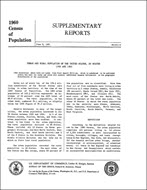
An official website of the United States government
Here’s how you know
Official websites use .gov
A .gov website belongs to an official government organization in the United States.
Secure .gov websites use HTTPS
A lock (
) or https:// means you’ve safely connected to the .gov website. Share sensitive information only on official, secure websites.
-
//
- Census.gov /
- Library /
- Publications /
- 1960 Census: Urban and Rural Population of the U.S.
1960 Census: Supplementary Reports: Urban and Rural Population of the United States, by States: 1960 and 1950
1960 Census: Supplementary Reports: Urban and Rural Population of the United States, by States: 1960 and 1950
According to the definition adopted for use in the 1960 Census, the urban population comprises all persons living in
(a) places of 2,500 inhabitants or more incorporated as cities, boroughs, villages, and towns (except towns in New England, New York, and Wisconsin);
(b) the densely settled urban fringe, whether incorporated or unincorporated, of urbanized areas;
(c) towns in New England and townships in New Jersey and Pennsylvania which contain no incorporated municipalities as subdivisions and have either 25,000 inhabitants or more or a population of 2,500 to 25,000 and a density of 1,500 persons or more per square mile;
(d) counties in States other than the New England States, New Jersey, and Pennsylvania that have no incorporated municipalities within their boundaries and have a density of 11 500 persons or more per square mile; and
(e) unincorporated places of 2,500 inhabitants or more.
The population not classified as urban constitutes the rural population. A more detailed discussion of the urban-rural definition and of the trends in the population by urban-rural residence will appear in Final Report PC(1)-1A.
The PDF to the right contains the 4-page report.
A Note on Language
Census statistics date back to 1790 and reflect the growth and change of the United States. Past census reports contain some terms that today’s readers may consider obsolete and inappropriate. As part of our goal to be open and transparent with the public, we are improving access to all Census Bureau original publications and statistics, which serve as a guide to the nation's history.
Share
Some content on this site is available in several different electronic formats. Some of the files may require a plug-in or additional software to view.
 Yes
Yes
 No
NoComments or suggestions?


Top

